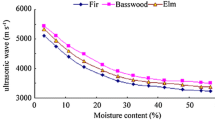Abstract
The effect of moisture content (MC) and temperature on the stress wave velocity and signal frequency spectrum through sapwood has been investigated. It was discovered that in 2.5 m long green boards only low frequencies were present in the transmitted signal, while for boards less than 500 mm long, the much higher resonance frequency of the transducer was dominant. For green boards between 0.5 and 2.5 m both low and high frequency components were present. The frequency spectrum was monitored for a 540 mm long board over a range of moisture contents and temperatures. When the MC was below 30% the transmitted signal waveform consisted almost entirely of the transducer resonance frequency, while at higher moisture contents, low frequency components predominated. The frequency spectrum of the transmitted signal was little affected by temperature, but it was affected by the type of transducers used. The effect of temperature and moisture content on stress wave velocity was studied and is displayed in the form of a three dimensional graph.
Similar content being viewed by others
Author information
Authors and Affiliations
Additional information
Received 3 May 1999
Rights and permissions
About this article
Cite this article
Kang, H., Booker, R. Variation of stress wave velocity with MC and temperature. Wood Science and Technology 36, 41–54 (2002). https://doi.org/10.1007/s00226-001-0129-x
Issue Date:
DOI: https://doi.org/10.1007/s00226-001-0129-x




